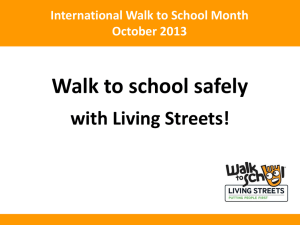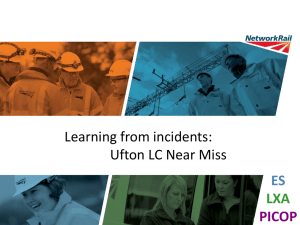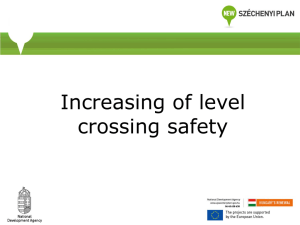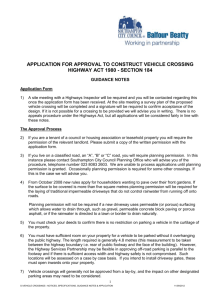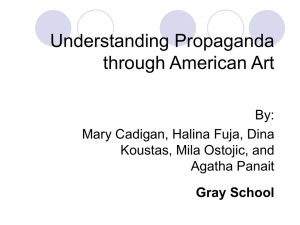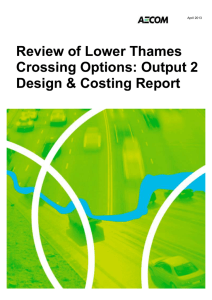Review of Lower Thames Crossing Capacity Options
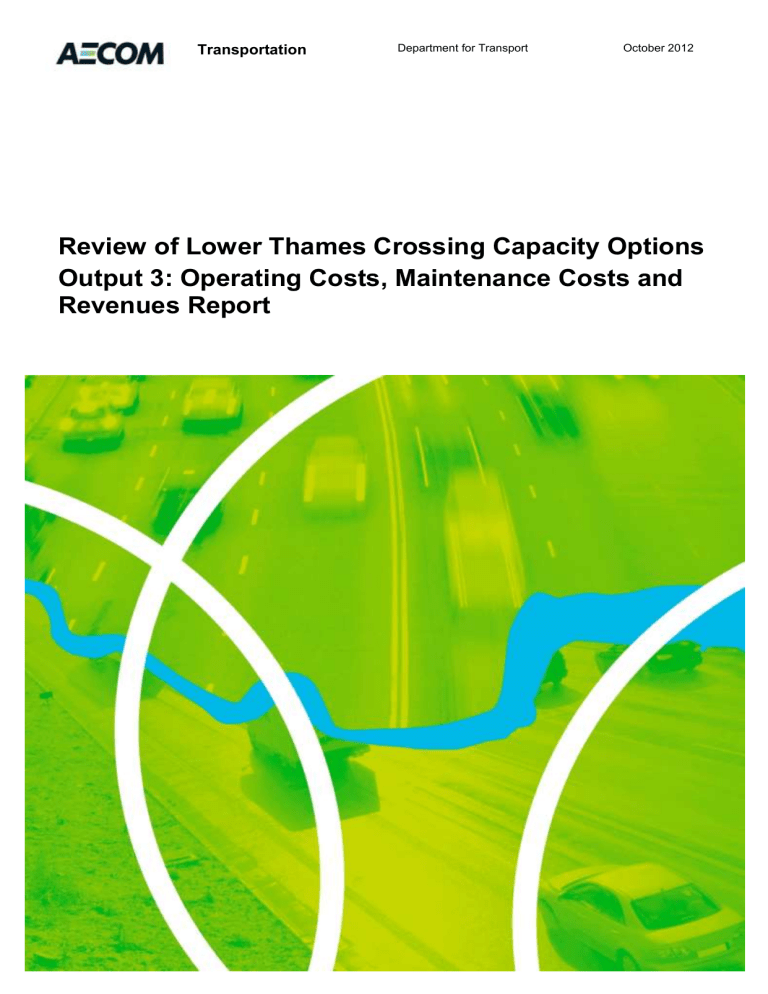
Transportation
Department for Transport October 2012
Review of Lower Thames Crossing Capacity Options
Output 3: Operating Costs, Maintenance Costs and
Revenues Report
Prepared by: .......................................................
Richard Lyon
Associate Director
Checked by: ..................................................................
Paul Hanson
Regional Director
Approved by: .......................................................
Ian Burrows
Associate Director
Review of Lower Thames Crossing Capacity Options: Output 3: Operating and Maintenance Costs and Revenues
Report
Rev No Comments Date
1
2
3
First draft issue;
Revised version following DfT/HA comments
Final version following further DfT/HA comments
Checked by
PH
PH
PH
Approved by
IB
IB
IB
03-10-12
29-10-12
26-11-12
Saxon House, 27 Duke Street, Chelmsford, Essex, CM1 1HT
Telephone: 01245 771200 Website: http://www.aecom.com
Job No 60249197 Reference Output 3: Operating and Maintenance Costs and Revenues Report
Date Created October 2012
This document has been prepared by AECOM Limited for the sole use of our client (the “Client”) and in accordance with generally accepted consultancy principles, the budget for fees and the terms of reference agreed between
AECOM Limited and the Client. Any information provided by third parties and referred to herein has not been checked or verified by AECOM Limited, unless otherwise expressly stated in the document. No third party may rely upon this document without the prior and express written agreement of AECOM Limited.
Although this report was commissioned by the Department for Transport (DfT), the findings and recommendations are those of the authors and do not necessarily represent the views of the DfT. The information or guidance in this document (including third party information, products and services), is provided by DfT on an 'as is' basis, without any representation or endorsement made and without warranty of any kind whether express or implied.
Table of Contents
1 Introduction
AECOM Review of Lower Thames Crossing Capacity Options
Report on Design and Costs 1
1 Introduction
1.1 Background
1.1.1 AECOM has been appointed by the Department for Transport (DfT) to undertake a study to provide an outline strategic business case for the three options (plus a variant) for providing additional river crossing capacity in the Lower Thames area. These options were identified in a previous study, the ‘Dartford River
Crossing Study (2009)’.
1.1.2 The objective of this study is to inform policy on where to provide a new crossing. It is not intended to determine a preferred route, or detailed design for a new crossing.
1.1.3 The study has been structured in three distinct stages.
The first stage was the establishment of a model to forecast traffic demand for a new crossing and hence suggest capacity requirements and estimate the economic benefits that a new crossing would provide.
The second stage involved the consideration of engineering feasibility and the establishment of capital cost estimates both for a new crossing and for infrastructure to link this with the existing road network.
The third stage comprises the interpretation of the evidence to assess the performance and impacts of the alternative crossings. This involves: o consideration of maintenance and operating costs for a new crossing, the subject of this report; o application of the traffic forecasting tool to estimate demand for the crossing options; o interpretation o f the evidence using the DfT’s five case business model to describe the performance separately for each of the options; and o the study report will summarise the findings.
1.2 Report Purpose
1.2.1 This document sets out the assumptions used to estimate operating and maintenance costs, the costs of revenue collection and revenues for an additional lower Thames Crossing separately for the three Options
A, B and C (together with the Option C Variant).
1.2.2 This complements the estimates of capital costs prepared in the second stage of the study to document assumptions used in developing the financial and commercial cases for a new crossing.
1.3 Overall Approach and Report Structure
1.3.1 The operating and maintenance costs will depend on detailed design decisions that will be made in the course of delivering a particular option. Our approach, therefore, has been to use benchmark evidence on the overall costs from existing infrastructure.
1.3.2 The inflation assumptions used to calculate costs are commercial inflation rates for all construction and renewal costs, and CPI elsewhere.
1.3.3 Reflecting the nature of the costs, we have considered routine operational and maintenance costs separately from the costs associated with revenue collection. Accordingly, this report is structured as follows:
Chapter 2 explains the derivation and presents the cost estimates associated with operating and maintaining the infrastructure required for each of the options.
Chapter 3 explains the basis of estimating the costs of collecting revenues using a free flow tolling system.
AECOM Review of Lower Thames Crossing Capacity Options
Report on Design and Costs
Chapter 4 briefly sets out the breakdown for routine and renewal maintenance costs for the structure and associated link roads, and
Chapter 5 explains the basis of estimating toll revenues.
2
2 Operational and Maintenance
Costs
AECOM
Capabilities on project:
Transportation
Review of Lower Thames Crossing Capacity Options 4
2 Operational and Maintenance Costs
2.1 Introduction
2.1.1 This chapter explains our estimation of operational and maintenance (O&M) costs. Estimates have been prepared for the route options developed in the Design and Costing Report and for the types of main crossing structure:
cable stayed bridge;
immersed tube tunnel; and
bored tunnel.
2.1.2 The Options include provision of both a new structure crossing the River Thames, together with new junctions and links connecting the structure to the existing road network. Upon opening this road infrastructure for public use costs will be incurred to enable the road to operate safely and to ensure it is kept in a serviceable condition. The following sections separately discuss costs associated with:
operational and regular maintenance costs, and
renewing elements of the road infrastructure, i.e. longer term maintenance.
2.2 Estimating Operational and Regular Maintenance Costs
2.2.1 Those requirements and tasks on road infrastructure to keep it in continuous use are operational requirements. For a tunnel, examples of operational requirements are the supply of energy, monitoring traffic and use of fire safety, ventilation equipment.
2.2.2 Costs attributable to tunnel operations tend to be significantly higher than for bridge crossings as energy requirements are much higher and the safety requirements are more onerous. The costs of operating the main crossing structure are greater than those costs for the approach roads. Notable operational tasks on roads are the use of communications equipment, road patrols, winter maintenance (i.e. application of salt and snow clearance), cleaning and inspections of the road infrastructure. Road lighting energy costs are also attributable to operations.
2.2.3 Regular, or cyclical, maintenance tasks are closely linked with operational costs and they relate to tasks undertaken to maintain the serviceable condition of the road infrastructure on a short term or seasonal basis.
Typically, for a road, regular maintenance can comprise grass cutting, cleaning, repairs to safety fencing road surface minor repairs etc. Higher costs for regular maintenance in a tunnel relate to the requirement to maintain the fire safety systems, ventilation equipment and, where necessary, drainage pumps. Lesser costs apply to a major bridge than for a tunnel because there is less equipment to maintain.
2.2.4 Costs for operating and maintaining the existing Dartford Crossing were not made available to AECOM for this study by the Highways Agency for commercial reasons. We used recent costs for a typical recent similar major tidal water crossing study, namely Additional Waitemata Harbour Crossing in New Zealand, which included bridge and tunnel options and dual two lane roads. These costs were adjusted by allowing for the difference in the cost of construction between the UK and New Zealand. This evidence was benchmarked against other major tunnel and bridge crossing schemes.
2.2.5 The sources within the evidence base include the provision of relatively short link roads comparable with
Options A and B. For the longer link roads required for Option C we have drawn on relevant cost data for operating and maintaining the UK trunk road network.
2.2.6 We assumed that the regular maintenance and operating costs are related to the size of the structure / roads. Using linear interpolation based on the road widths and lengths, the benchmarked costs were applied to estimate costs for the bridge, immersed tube and bored tunnels for each of Options A, B and C.
AECOM
Capabilities on project:
Transportation
Review of Lower Thames Crossing Capacity Options 5
2.2.7 The Option C variant comprises 3.3km long single carriageway tunnel through the North Downs. The overseas study sourced costs were used but adjusted for the single carriageway and its comparative length.
It was considered that the higher ventilation costs incurred due to the steeper gradients were countered by the reduced costs of not passing under a major river; i.e. pumped drainage provision etc.
2.2.8 Table 1 below shows the estimated annual operating and routine maintenance costs. The costs stated below have been calculated to represent an average cost per annum considering the total 60 year cost.
Table 1: Annual Estimated Operating and Routine Maintenance Costs (2012 prices)
Option A
Option B
Option C
C Variant
Structure Type
Bridge
Immersed Tunnel
Bored Tunnel
Bridge
Immersed Tunnel
Bored Tunnel
Bridge
Immersed Tunnel
Bored Tunnel
Annual O&M Costs
£0.9M
£3.8M
£3.6M
£1.3M
£4.7M
£5.0M
£2.4M
£7.8M
£7.9M
£2.7M
Note: Costs exclude VAT, although non-recoverable VAT is included
2.2.9 Based on our benchmarking of these cost rates we would expect costs to be within a range of ±30% of these estimates. These costs reflect a range of aspects and we would therefore assume that they would increase over time in line with the consumer price index.
2.3 Renewal Maintenance Costs
2.3.1 Renewal maintenance relates to planned works to repair or replace the road infrastructure to keep it fit for use. Annual maintenance costs will vary according to the lifetime of the individual components. The maintenance cycle will depend on detailed design decisions on the materials and components. We have, therefore, estimated annual average costs for the purposes of this study.
2.3.2 For a tunnel, items needing to be replaced on a planned basis include mechanical and electrical equipment and road surfacing. Whereas for a major bridge, major items for replacement include bridge bearings, road deck joints, road surfacing and corrosion protection works.
2.3.3 For the major crossing structure adjacent link roads and the tunnel for Option C variant, we have drawn on
required for Option C we have drawn on data made available from the Highways Agency’s Trunk Road maintenance statistics to calculate costs outside the approach roads area.
2.3.4 The benchmark costs were interpreted, using linear interpolation based on the dimensions of the illustrative designs, to estimate costs for each of options assessed.
AECOM
Capabilities on project:
Transportation
Review of Lower Thames Crossing Capacity Options 6
2.3.5 Table 2 below shows the renewal maintenance costs estimates.
Table 2: Annual Average Maintenance Renewal Costs (2012 prices)
Option A
Option B
Option C
C Variant
Structure Type
Bridge
Immersed Tunnel
Bored Tunnel
Bridge
Immersed Tunnel
Bored Tunnel
Bridge
Immersed Tunnel
Bored Tunnel
Annual Renewal Costs
£0.4M
£1.3M
£1.2M
£0.6M
£1.6M
£1.7M
£2.8M
£4.2M
£4.2M
£0.9M
Note: Costs exclude VAT on the basis that the works will be on existing highway land
2.3.6 Based on our benchmarking of these cost rates we would expect costs to be within a range of ±30% of these estimates. These costs mainly reflect capital costs and we would therefore assume that they would increase over time in line with the construction cost prices.
3 Revenue Collection Costs
AECOM
Capabilities on project:
Transportation
Review of Lower Thames Crossing Capacity Options
3 Revenue Collection Costs
8
3.1 Introduction
3.1.1 The operation of free-flow tolling is achieved through mechanisms to detect, invoice and collect money from users. There are a range of technologies and procedures that can be applied for these operations and detailed decisions on the method of implementation will affect the costs. For our strategic study objectives, therefore, we have considered the broad requirements of these activities and applied benchmark evidence to indicate cost ranges. We have assumed a single process covering existing and new crossings. We discuss the key stages in turn below.
3.1.2 Except where stated otherwise, monetary values in this chapter are quoted in 2010 prices, excluding VAT.
3.2 Sources
3.2.1 Some estimates of aspect associated with cost of analogous schemes were made during work undertaken by AECOM for the Irish National Roads Authority (NRA) based on assessing several existing free-flow tolling schemes.
3.2.2 The cost of operating the free-flow tolling scheme on the existing crossing has previously been estimated as part of the appraisal of that scheme, in “Dartford Free-Flow Charging Project: Outline Business Case”, dated
May 2012.
3.3 Detection and Debtor Identification
3.3.1 This involves procedures to identify the vehicle and registered owner. Detection can be based on electronic devices mounted in the car using a range of technologies. However, unless some form of manual toll plaza is operated or unregistered users are prohibited from using the scheme, some means are additionally required to identify the vehicles. We have assumed that these would be through the use of Automatic
Number Plate Recognition (ANPR). Indeed, with the installation of ANPR cameras, there might be limited value in additionally using separate electronic devices to recognise specific vehicles.
3.3.2 Procedures for identification for payment enforcement from number plates are well established through, for example, the parking industry and for the London Congestion Charge.
3.3.3 However character recognition methods used by ANPR cameras are insufficiently reliable to act as the sole identifier of vehicles, and some manual processing will therefore be required. The extent and costs will depend on a range of factors, but given the unacceptability of incorrect invoicing, the manual checking required is likely to be required for a substantial proportion of vehicles using the crossing.
3.3.4 The free-flow charging business case estimated an annual maintenance cost of about £5.5 million for detection equipment. Given the additional capacity is assumed to be approximately half the existing capacity
(two lanes rather than f our) the additional maintenance cost might be expected to be between £2m and £3m per annum. Currently there are over 40 million vehicles using the crossing during charged daytime hours, which is forecast to increase to about 50m without additional capacity and about 70m with an additional crossing. This implies that the detection equipment maintenance cost could be about 11p per transaction
3.3.5 The cost of manual checking would depend on policy adopted in respect of the required invoicing accuracy, in part this is reflecting the costs of appeals procedures and in part reflecting customer perceptions and reputation. The available evidence shows considerable variation in different locations and for costing purposes we have made central assumptions from the evidence available to us that:
50% of transactions will require manual verification; allowing for overheads / management / etc total annual cost of each employee would be about
£30k; and about 60,000 number plate photographs can be processed per full-time employee per month;
AECOM
Capabilities on project:
Transportation
Review of Lower Thames Crossing Capacity Options 9
an average of 1.5 checks will be required to verify these transactions.
3.3.6 These assumptions are consistent with the free-flow charging business case report. Based on these assumptions we would estimate that the manual verification would cost about 3 pence per transaction.
3.3.7 Some vehicles will be unreadable; either because of equipment failure or because of obscured number plates. These have been treated as reducing revenue (Chapter 4), rather than increasing cost.
3.4 Payment
3.4.1 There is a substantial difference in cost between different payment methods. Electronic transfer of funds typically costs a few pence per transaction. Payment by cheque or equivalent can incur costs in the region of
£1, including invoice postage, etc. Where users register and provide banking details, low cost automated, electronic payment and invoicing systems can be applied. However for unregistered users, where invoices must be posted, costs can be significantly higher.
3.4.2 Accordingly, measures taken to encourage users to register in some way are likely to reduce net operating costs. Such measures would include the existing, or similar DartTAG scheme, but also may include web and call centre based facilities to allow users to register. There may also be consideration given to discounting charges for registered users to provide an incentive.
3.4.3 Evidence from free-flow tolling operations indicate that:
30%-70% of transactions are typically made by account holders; DartTAG users currently comprise 30% of vehicles using the Dartford crossing and the free flow business case assumes that this will increase to 49%;.
20%90% of payments by ‘unregistered’ users might be made by credit card or through retail outlets, assuming that payment channels are made available
3.4.4 Allowing for the possibility that some users may be invoiced monthly rather than per transaction, we have assumed that bank charges and invoicing costs would average at about 20p per transaction.
3.4.5 In addition, there would be a need to operate a customer call centre to respond to questions. Based on evidence from similar operations between 50-150 full-time customer service operatives are likely to be required to deal with queries arising from 70m transactions per annum. (This assumes 3 minutes per query,
3 queries per account holder per year, and a query from 15% of non-account-holder trips) 1 .
3.4.6 This implies around 6 pence per transaction, assuming £30,000 total employment and overhead costs per person.
3.5 Enforcement
3.5.1 While most users will pay, either through registering or by paying for individual transactions (in shops, online or by phone) it is to be expected that a number will not. It is to be expected that some form of fines and enforcement protocol will be applied in these circumstances.
3.5.2 It is assumed here that fines for failure to pay will be set at such a level that, accounting for users who do not or cannot be compelled to pay fines, the fines will recover the costs involved with enforcement (such as posting letters, on-road enforcement, and appropriate legal proceedings). It has therefore been assumed that the net effect of enforcement costs is nil.
3.6 Summary of Costs
3.6.1 Table 3 summarises our estimate of revenue collection operating cost rates per transaction.
1 By way of comparison TfL’s London Congestion Charge scheme employs about 350 call centre staff
AECOM
Capabilities on project:
Transportation
Review of Lower Thames Crossing Capacity Options 10
Table 3: Estimated Operating Cost per Transaction (2010 prices)
Cost
Detection and ANPR IT equipment
ANPR manual checking staff
Customer Service invoice and payment
Enforcement
Total
£/transaction
£0.11
£0.03
£0..06
£0.20
£0.00
£0.40
3.6.2 Our benchmarking evidence indicates considerable variation in costs from different crossing operations. We would expect costs to be within a range of ±50% of these estimates. These costs reflect wage and capital costs, nevertheless there will be scope for productivity improvements over time and we would therefore assume that costs would increase in line with CPI over time.
4 Maintenance Cost Breakdown
ECOM
Capabilities on project:
Transportation
Review of Lower Thames Crossing Capacity Options 12
4 Maintenance Cost Breakdown
4.1 Introduction
4.1.1 The data sources for operating and maintenance costs are limited and do not provide sufficient evidence to provide robust and detailed breakdown of these costs between the structure and link roads. We have therefore considered cost rates for the link roads and used our professional judgement to interpret the balance of costs between the main structure and supporting infrastructure.
4.2 Routine Operating and Maintenance Costs
4.2.1 On this basis, we would apportion the following range of routine operating and maintenance (O&M) costs for the structure and associated link roads for each Crossing location as follows:
Table 4: Routine Maintenance Cost Range Splits
Crossing Option Range of costs allocated to
Structure
Range of costs allocated to link roads
Option A
Option B
93% to 98%
95% to 98%
7% to 2%
5% to 2%
Option C 87% to 95% 13% to 5%
4.2.2 It is noted that the costs allocated to a bridge structure are generally towards the lower end of the range when compared against other crossing structures, such as an immersed or bored tunnel.
4.2.3 Given the scale of operating and maintenance costs in proportion to capital costs and the conclusion that the vast majority of cost is attributed to the structure, we would suggest a simplification of allocating all operating and maintenance costs to the structure for the purposes of testing whether revenues cover structure only costs.
4.3 Renewal Operating and Maintenance Costs
4.3.1 In respect of renewal maintenance costs, we estimate that the costs would be allocated between the structure and the link roads as follows:
Table 5: Renewal Maintenance Cost Range Splits
Crossing Option Range of costs allocated to
Structure
Range of costs allocated to link roads
Option A
Option B
60% to 75%
60% to 65%
25% to 40%
35% to 40%
Option C 35% to 50% 50% to 65%
4.3.2 By considering the above, 65% of renewals costs should be assumed for Options A and B and 45% for
Option C for financial assessment. This reflects the uncertainties at this stage and the relatively small costs for renewals compared with initial capital costs.
5 Revenue
5 Revenue
5.1 Introduction
5.1.1 Estimation of revenue comprises two steps; estimating flows on the crossings by vehicle class (car, 2-axle other vehicles, and 3+ axle other vehicles), and estimating average toll paid by vehicle class. This chapter explains the derivation of average toll paid by vehicle class.
5.2 Estimating Traffic Volumes
5.2.1 Flows by vehicle class were forecast by the model. Cars correspond directly to a modelled segment and user class. The model LGV and HGV (Light and Heavy Good Vehicle) segments were used to estimate flows for the other two pay classes; all LGVs were assumed to be 2 axle, while a proportion of HGVs (21%) were also assumed to be 2 axle. This value was derived from analysis of DfT manual classified count data immediately to the north and south of the existing crossing.
5.2.2 The Crossing is not charged between 10pm and 6am and it is assumed a new crossing will follow the same approach. The annualisation data used to obtain annual flows therefore excludes night-time travel. The annualisation factors used are shown in Table 4, derived from Dartford Crossing transaction data:
Table 4: Annualisation Factors
AM Peak
PM Peak
Interpeak
Light
724
691
3,784
Heavy
777
779
2,608
5.2.3 Flows for years between 2009 and 2041 were derived by multiplicative interpolation between the modelled years of 2009, 2025 and 2041. Flows for years beyond 2041 were assumed static in the “without scheme” case, on the basis that the crossing is essentially at capacity; and assumed to grow at half the rate beyond
2041 that they grew at between 2025 and 2041 in the scheme cases.
5.3 Estimating Average Tolls
5.3.1 Tolls have been assumed as shown in Table 5, expressed in nominal prices. Beyond 2015, tolls are assumed to increase with CPI (assumed 2% per annum) in line with the transport model input assumptions.
Between 2009 and 2014, the planned and announced future increases to toll levels are explicitly incorporated.
Table 5: 2009 Dartford Tolls, actual cash values
Car
LGV
HGV
Cash
£1.50
£2.00
£3.70
2009-2012
TAG
£1.00
£1.75
£3.20
Local
£0.20
-
-
Cash
£2.00
£2.70
£4.90
2013-2014
TAG
£1.30
£2.30
£4.30
Local
£0.20
-
-
Cash
£2.50
£3.30
£6.20
2015+
TAG
£1.70
£2.90
£5.30
5.3.2 These tolls were rebased to 2010 prices throughout, and averages derived over cash, TAG, local-resident and exempt (‘no pay’) vehicles to obtain average values for calculating revenue by vehicle type.
5.3.3 Dartford Crossing transaction data have been used to derive payment type proportions, as shown in Table 6.
It has been assumed that the introduction of free-flow tolling will result in increases in TAG proportions, taken from assumptions in the free-flow tolling business case report.
Local
£0.20
-
-
14
Документ1
Table 6: 2009 Dartford Payment Type Proportions
Car
LGV
HGV
TAG
22.9%
41.0%
70.7%
2009-2014
Local
Residents Cash Exempt
4.9% 70.9% 1.2%
0.0%
0.0%
58.3%
29.0%
0.7%
0.3%
TAG
46.9%
43.0%
70.7%
2015+
Local
Residents
4.9%
Cash Exempt
47.0% 1.2%
0.0%
0.0%
56.3%
29.0%
0.7%
0.3%
5.3.4 The final average tolls assumed in estimation of revenue, in 2010 prices, are shown in Table 7. From 2015 onwards they assume an additional 1.5% non-compliance; users who should pay, but are not identified by the detection systems, derived by review of similar free-flow tolling systems elsewhere.
Table 7: Tolls for Revenue Estimation
Car
2axle
3axle
2010-2012
£1.35
£1.95
£3.45
2013-2014
£1.62
£2.33
£4.15
2015+
£1.71
£2.67
£4.77
Документ1
15
